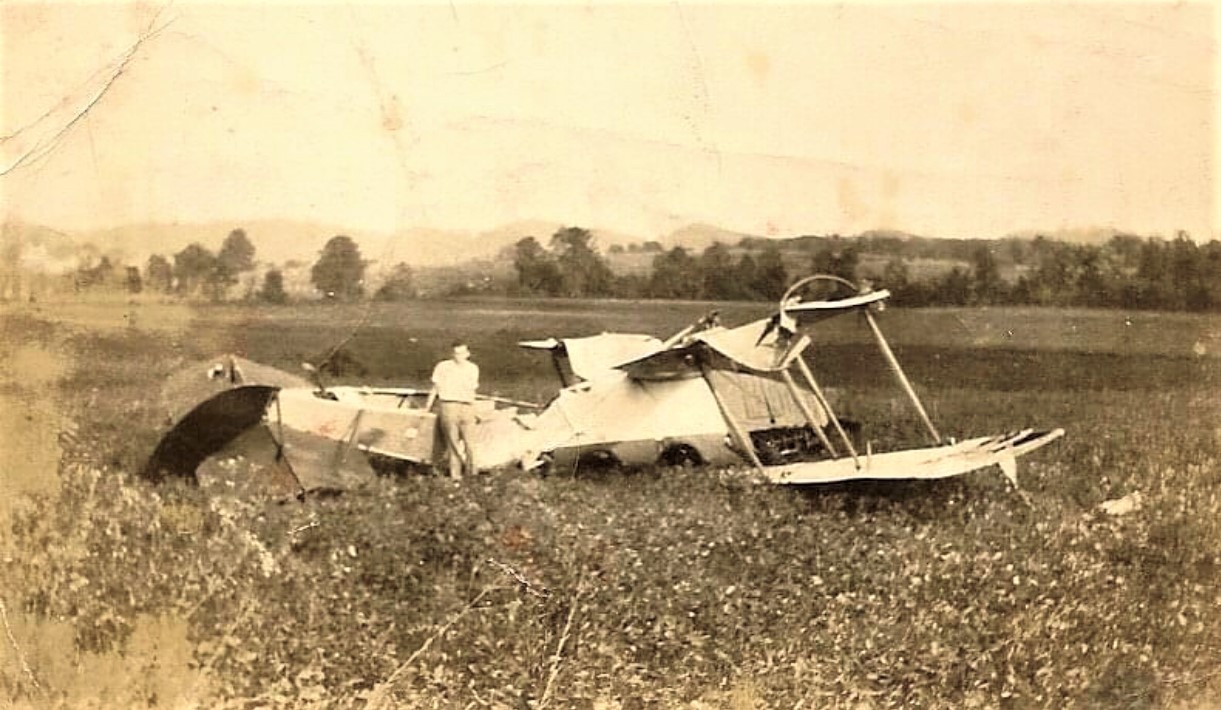Back in 1929, a cheeky local stunt pilot named Patrick Joseph Beavers decided to take an aerial tour of the recently completed Andrew Johnson Hotel, at the time the tallest building in downtown Knoxville. After making a couple of circles around the building, he realized he was losing altitude and needed to come up with a plan.
“He had to decide whether he was going to ditch it in the river or make it back to the airport,” said Bill Beavers, Patrick’s son. “He decided he had enough altitude to make the airport. He almost made it. He lacked one foot of clearing a big oak tree. The plane nosedived into the ground. Luckily, he walked away from it, or I wouldn’t be here.”

Patrick Beavers lifts off from old McGhee Tyson Airport. Photo courtesy of Bill Beavers.
The airport, such as it was, wasn’t Downtown Island (it didn’t exist yet) nor the current McGhee Tyson Airport in Alcoa. And before there was a McGhee Tyson it was simply known as Sutherland Airfield, where West High School and the National Guard Armory now sit. It was basically a cow pasture with a landing strip in the middle of it.
By the time Patrick Beavers had his brush with fate in 1929, Knoxville had already prohibited stunt flying in the city limits. But that didn’t stop him (or many other pilots) from doing it anyway. Bill said his father flew under the Gay Street Bridge and regularly participated in the air circuses on Sundays. But it wasn’t all fun and games.
“He flew reporters from Knoxville to Dayton and back for the Scopes Trial (1925),” Beavers said. “It’s really something. He flew four generations of my family from that airfield before I was even born: my oldest sister, himself, his parents and his grandparents. It’s quite a history.”

Charles McGhee Tyson
By 1930, the city of Knoxville had purchased the airfield. It was renamed McGhee Tyson Airport, after Charles McGhee Tyson, the son of a prominent local family who donated the land for what became Tyson Park. A graduate of Princeton University, he enlisted in the Naval Reserve Flying Corp in 1917 during World War I. Near the end of the war, he transferred to England as a lieutenant and served with an aerial unit that dropped mines in the North Sea to combat German U-boats. On October 11, 1918, he volunteered for a mine laying mission and served as the nose gunner. He was killed when the plane crashed into the North Sea near the Humber River. His parents, Lawrence D. and Betty McGhee Tyson, stipulated that, for the donation of the land, the Knoxville airport be named for their son.
By the mid-1930s, the small airstrip in Bearden was not keeping pace with the growth of air travel. So, the city purchased 351 acres land in Blount County to build a new one. Which is why, even though it’s not even located in Knox County, it’s still the Knoxville airport, under the ownership and management of the Metropolitan Knoxville Airport Authority, which was created in 1972.
The first flight to the new McGhee Tyson Airport touched down 84 years ago on July 29, 1937. And the old Sutherland Airfield was shut down for good. West High School was built in 1951.
Beth Kinnane is the community news editor for KnoxTNToday.com



